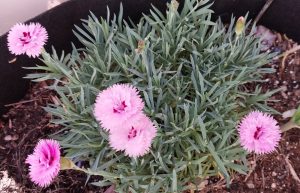When shopping for garden flowers, what do you look for when making your purchase? Color and fragrance, of course. However, there is another attribute to consider, reputation and historical significance. A certain variety of flowers has walked with brides, the Virgin Mary, and even Greek Gods.
Being known by many names—Sweet William, pinks, cheddar pinks, gillyflowers and maiden pinks—attests to the popularity and longevity of dianthus. The clove-scented flowers are native to the Mediterranean, western part of Asia, and the Balkan Peninsula. Within time they spread to all of Europe and then North America.
Dianthus was known as the “divine flower” because of its connection to the gods and divinity. The name dianthus comes from the Greek word for God (Dios) and flower (anthos), or flower of the Gods. In Japan, dianthus is known as Hana-fuki or “to be blown away.” The translation implies that inhaling the fragrance makes your troubles blow away in the wind.
Dianthus’ history is divided between sadness and joy. During the Victorian era the spicy, fragrant flowers demonstrated love, affection, gratitude, and admiration. White dianthus symbolizes a mother’s love and, to this day, is used in Mother’s Day bouquets. To Christians, dianthus represented the suffering of Jesus and Mary; it grew where Mary’s tears fell onto the earth following the crucifixion. The Dutch believe carnations, part of the dianthus family, symbolize the remembrance of World War II and war veterans. Flowers with such an emotional and sensory impact are significant, both to our history and to our souls.
Dianthus arrived in North America in the 1670s. The growing season was short; the plants rapidly went to seed. The idea was to enjoy them quickly because flowers and fragrance would die away. In the 1960s a hybrid was developed by crossing two non-seed-setting species. That extended the blooming season, increasing popularity.
There are around 300 species in the dianthus genus. Frequently-found varieties in nurseries include D. barbatus or sweet William, D. plumarius or pinks, and D. chinensis or China pinks. Blooms appear in colors of pink, red, white, purple, and variegated. The five petals have jagged or fringed edges, looking as though they are trimmed with pinking shears (perhaps the origin of the name ‘pinks?’). Foliage is gray-green and often mounding. Depending on the plant location, in warmer zones it may grow as a tender perennial.
Your dianthus will enjoy full sun (or at least six hours of sunlight). Water plants when dry and apply fertilizer every six to eight weeks for continuous blooms from May through October. A quick deadheading of spent flowers will continue colorful blooms. Watering at the base of the plant helps prevent mildew and disease. Dianthus is perfect for containers and borders.
With so many varieties, how to choose? The variety most-used by florists is Dianthus caryophyllus or carnations. The variety most found in the home garden is garden pinks or Dianthus plumarius. Sweet William, D. barbatus, is a pollinator siren calling to butterflies, insects, and hummingbirds.
The history of dianthus—with its relationship to William Shakespeare, Diana the Goddess of the Hunt, the Virgin Mary, and art from the Middle Ages—proves these flowers are important and relevant. Pinks have held a place in our hearts for hundreds of years. Today these plants will provide joy and meaning in your garden, too.
Julie Silva is a University of California Cooperative Extension Master Gardener of Tuolumne County.

